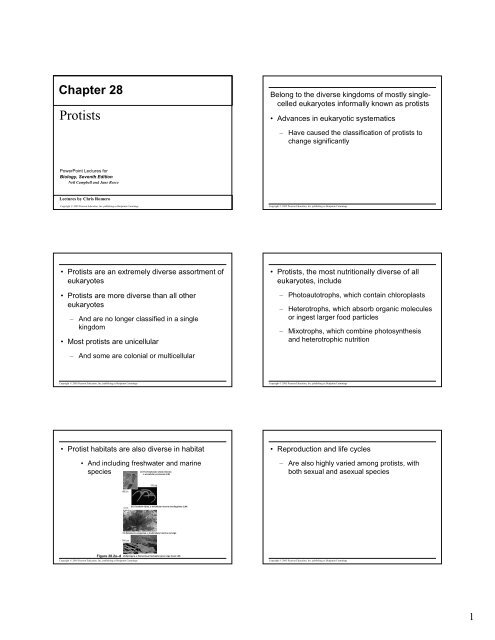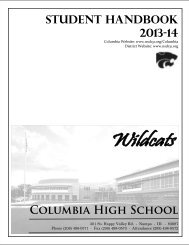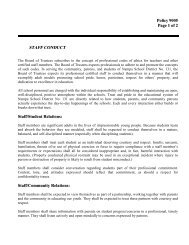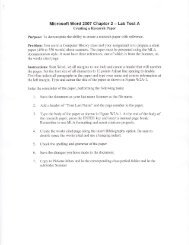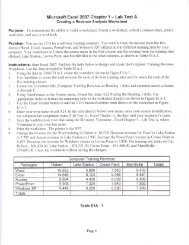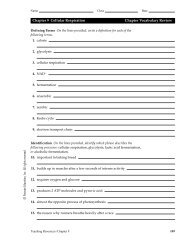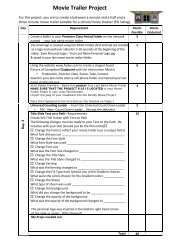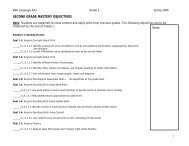Microsoft PowerPoint - 28- protists revised.pdf - NSD Main
Microsoft PowerPoint - 28- protists revised.pdf - NSD Main
Microsoft PowerPoint - 28- protists revised.pdf - NSD Main
You also want an ePaper? Increase the reach of your titles
YUMPU automatically turns print PDFs into web optimized ePapers that Google loves.
Chapter <strong>28</strong>ProtistsBelong to the diverse kingdoms of mostly singlecelledeukaryotes informally known as <strong>protists</strong>• Advances in eukaryotic systematics– Have caused the classification of <strong>protists</strong> tochange significantly<strong>PowerPoint</strong> Lectures forBiology, Seventh EditionNeil Campbell and Jane ReeceLectures by Chris RomeroCopyright © 2005 Pearson Education, Inc. publishing as Benjamin CummingsCopyright © 2005 Pearson Education, Inc. publishing as Benjamin Cummings• Protists are an extremely diverse assortment ofeukaryotes• Protists are more diverse than all othereukaryotes– And are no longer classified in a singlekingdom• Most <strong>protists</strong> are unicellular• Protists, the most nutritionally diverse of alleukaryotes, include– Photoautotrophs, which contain chloroplasts– Heterotrophs, which absorb organic moleculesor ingest larger food particles– Mixotrophs, which combine photosynthesisand heterotrophic nutrition– And some are colonial or multicellularCopyright © 2005 Pearson Education, Inc. publishing as Benjamin CummingsCopyright © 2005 Pearson Education, Inc. publishing as Benjamin Cummings• Protist habitats are also diverse in habitat• And including freshwater and marine(a) The freshwater ciliate Stentor,speciesa unicellular protozoan (LM)• Reproduction and life cycles– Are also highly varied among <strong>protists</strong>, withboth sexual and asexual species100 µm100 µm4 cm(b)Ceratium tripos, a unicellular marine dinoflagellate (LM)(c) Delesseria sanguinea, a multicellular marine red alga500 µmFigure <strong>28</strong>.2a–d (d) Spirogyra, a filamentous freshwater green alga (inset LM)Copyright © 2005 Pearson Education, Inc. publishing as Benjamin CummingsCopyright © 2005 Pearson Education, Inc. publishing as Benjamin Cummings1
• A sample of protist diversityEndosymbiosis in Eukaryotic Evolution• There is now considerable evidence– That much of protist diversity has its origins inendosymbiosisTable <strong>28</strong>.1Copyright © 2005 Pearson Education, Inc. publishing as Benjamin CummingsCopyright © 2005 Pearson Education, Inc. publishing as Benjamin Cummings• The plastid-bearing lineage of <strong>protists</strong>– Evolved into red algae and green algaeDiplomonads• Diplomonads– Have two nuclei and multiple flagella• On several occasions during eukaryoticevolution– Red algae and green algae underwentsecondary endosymbiosis, in which theythemselves were ingestedFigure <strong>28</strong>.5a(a) Giardia intestinalis, a diplomonad (colorized SEM)5 µmCopyright © 2005 Pearson Education, Inc. publishing as Benjamin CummingsCopyright © 2005 Pearson Education, Inc. publishing as Benjamin CummingsParabasalids• Parabasalids include trichomonads– Which move by means of flagella and anundulating part of the plasma membraneFlagella• Euglenozoans have flagella with a uniqueinternal structure– Is the presence of a spiral or crystalline rod ofunknown function inside their flagellaUndulating membrane 5 µmFigure <strong>28</strong>.5b (b) Trichomonas vaginalis, a parabasalid (colorized SEM)Copyright © 2005 Pearson Education, Inc. publishing as Benjamin CummingsCopyright © 2005 Pearson Education, Inc. publishing as Benjamin Cummings2
Kinetoplastids• Kinetoplastids– Have a single, large mitochondrion thatcontains an organized mass of DNA called akinetoplast• The parasitic kinetoplastid Trypanosoma– Causes sleeping sickness in humansFigure <strong>28</strong>.79 µmCopyright © 2005 Pearson Education, Inc. publishing as Benjamin CummingsCopyright © 2005 Pearson Education, Inc. publishing as Benjamin CummingsEuglenids• Euglenids– Have one or two flagella that emerge from apocket at one end of the cell• Alveolates have sacs beneath the plasmamembraneLong flagellumEyespot: pigmentedorganelle that functionsas a light shield, allowinglight from only a certaindirection to strike thelight detectorShort flagellumLight detector: swelling near thebase of the long flagellum; detectslight that is not blocked by theeyespot; as a result, Euglena movestoward light of appropriateintensity, an important adaptationthat enhances photosynthesis0.2 µmFlagellumAlveoliEuglena (LM)5 µmNucleusContractile vacuolePlasma membranePellicle: protein bands beneaththe plasma membrane thatprovide strength and flexibilityFigure <strong>28</strong>.8(Euglena lacks a cell wall)Copyright © 2005 Pearson Education, Inc. publishing as Benjamin CummingsChloroplastParamylon granuleFigure <strong>28</strong>.9Copyright © 2005 Pearson Education, Inc. publishing as Benjamin CummingsDinoflagellates• Dinoflagellates• Rapid growth of some dinoflagellates– Are a diverse group of aquatic photoautotrophsand heterotrophs– Is responsible for causing “red tides,” whichcan be toxic to humans– internal plates of cellulose• Two flagella– Make them spin as they move through thewaterCopyright © 2005 Pearson Education, Inc. publishing as Benjamin CummingsCopyright © 2005 Pearson Education, Inc. publishing as Benjamin Cummings3
Apicomplexans• Apicomplexans– Are parasites of animals and some causeserious human diseases– Are so named because one end, the apex,contains a complex of organelles specializedfor penetrating host cells and tissues– Have a nonphotosynthetic plastid, theapicoplast• Most apicomplexans have intricate life cycles– With both sexual and asexual stages that often requiretwo or more different host species for completion1 An infected Anopheles2 The sporozoites enter the person’smosquito bites a person,liver cells. After several days, the sporozoitesinjecting Plasmodiumundergo multiple divisions and becomesporozoites in its saliva.merozoites, which use their apical complexto penetrate red blood cells (see TEM below).Inside mosquitoInside humanMerozoiteSporozoites(n)Liver7 An oocyst developsfrom the zygote in the wallLiver cellof the mosquito’s gut. Theoocyst releases thousandsof sporozoites, whichOocystApexmigrate to the mosquito’ssalivary gland. MEIOSISMerozoiteRed blood 0.5 µm(n)cellZygoteRed blood(2n)cells3 The merozoites divide asexually inside thered blood cells. At intervals of 48 or 72 hours(depending on the species), large numbers ofmerozoites break out of the blood cells, causingperiodic chills and fever. Some of the merozoitesFERTILIZATIONinfect new red blood cells.KeyHaploid (n)Diploid (2n)GametesGametocytes(n)4 Some merozoitesform gametocytes.Copyright © 2005 Pearson Education, Inc. publishing as Benjamin Cummings6 Gametes form from gametocytes.Fertilization occurs in the mosquito’sFigure <strong>28</strong>.11 digestive tract, and a zygote forms.The zygote is the only diploid stagein the life cycle.Copyright © 2005 Pearson Education, Inc. publishing as Benjamin Cummings5 Another Anopheles mosquitobites the infected person and picksup Plasmodium gametocytes alongwith blood.Ciliates• Ciliates, a large varied group of <strong>protists</strong>• The micronuclei– Are named for their use of cilia to move andfeed– Have large macronuclei and small micronuclei– Function during conjugation, a sexual processthat produces genetic variation• Conjugation is separate from reproduction– Which generally occurs by binary fissionCopyright © 2005 Pearson Education, Inc. publishing as Benjamin CummingsCopyright © 2005 Pearson Education, Inc. publishing as Benjamin Cummings• Concept <strong>28</strong>.5: Stramenopiles have “hairy” andsmooth flagella• The clade Stramenopila– Includes several groups of heterotrophs aswell as certain groups of algaeOomycetes (Water Molds and Their Relatives)• Oomycetes– Include water molds, white rusts, and downymildews– Were once considered fungi based onmorphological studiesCopyright © 2005 Pearson Education, Inc. publishing as Benjamin CummingsCopyright © 2005 Pearson Education, Inc. publishing as Benjamin Cummings4
3 µmDiatoms• Most oomycetes– Are decomposers or parasites– Have filaments (hyphae) that facilitate nutrientuptake• Diatoms are unicellular algae– With a unique two-part, glass-like wall ofhydrated silica– Phytophthora infestans causes late blight ofpotatoesFigure <strong>28</strong>.15Copyright © 2005 Pearson Education, Inc. publishing as Benjamin CummingsCopyright © 2005 Pearson Education, Inc. publishing as Benjamin CummingsGolden Algae• Accumulations of fossilized diatom walls– Compose much of the sediments known asdiatomaceous earth• Golden algae, or chrysophytes– Are named for their color, which results fromtheir yellow and brown carotenoids– Are typically biflagellated, with both flagellaattached near one end of the cellCopyright © 2005 Pearson Education, Inc. publishing as Benjamin CummingsCopyright © 2005 Pearson Education, Inc. publishing as Benjamin CummingsBrown Algae• Most golden algae are unicellular– But some are colonial25 µm• Brown algae, or phaeophytes– Are the largest and most complex algae– Are all multicellular, and most are marine• Seaweeds– Have the most complex multicellular anatomyof all algaeFigure <strong>28</strong>.17Copyright © 2005 Pearson Education, Inc. publishing as Benjamin CummingsCopyright © 2005 Pearson Education, Inc. publishing as Benjamin Cummings5
• Kelps, or giant seaweeds– Live in deep parts of the oceanAlternation of Generations• The most complex life cycles include analternation of generations– The alternation of multicellular haploid anddiploid formsFigure <strong>28</strong>.19Copyright © 2005 Pearson Education, Inc. publishing as Benjamin CummingsCopyright © 2005 Pearson Education, Inc. publishing as Benjamin CummingsCercozoans and radiolarians have threadlikepseudopodia• A newly recognized clade, Cercozoa– Contains a diversity of species that are amongthe organisms referred to as amoebas• Amoebas were formerly defined as <strong>protists</strong>– That move and feed by means of pseudopodia• Cercozoans are distinguished from most otheramoebas– By their threadlike pseudopodiaCopyright © 2005 Pearson Education, Inc. publishing as Benjamin CummingsForaminiferans (Forams)• Foraminiferans, or forams– Are named for their porous, generallymultichambered shells, called testsFigure <strong>28</strong>.22Copyright © 2005 Pearson Education, Inc. publishing as Benjamin Cummings20 µm• Pseudopodia extend through the pores in thetestRadiolarians• Radiolarians are marine <strong>protists</strong>– made of silica– That phagocytose microorganisms with theirpseudopodiaCopyright © 2005 Pearson Education, Inc. publishing as Benjamin CummingsCopyright © 2005 Pearson Education, Inc. publishing as Benjamin Cummings6
Amoebozoans have lobe-shaped pseudopodia• Amoebozoans– Are amoeba that have lobe-shaped, ratherthan threadlike, pseudopodiaGymnamoebas• Gymnamoebas– Are common unicellular amoebozoans in soilas well as freshwater and marineenvironments– Include gymnamoebas, entamoebas, andslime moldsCopyright © 2005 Pearson Education, Inc. publishing as Benjamin CummingsCopyright © 2005 Pearson Education, Inc. publishing as Benjamin Cummings• Most gymnamoebas are heterotrophic– And actively seek and consume bacteria andother <strong>protists</strong>Entamoebas• Entamoebas– Are parasites of vertebrates and someinvertebrates40 µmPseudopodia• Entamoeba histolytica– Causes amebic dysentery in humansFigure <strong>28</strong>.24Copyright © 2005 Pearson Education, Inc. publishing as Benjamin CummingsCopyright © 2005 Pearson Education, Inc. publishing as Benjamin CummingsSlime Molds• Slime molds, or mycetozoans– Were once thought to be fungi• Molecular systematicsPlasmodial Slime Molds• Many species of plasmodial slime molds– Are brightly pigmented, usually yellow ororange4 cm– Places slime molds in the clade AmoebozoaFigure <strong>28</strong>.25Copyright © 2005 Pearson Education, Inc. publishing as Benjamin CummingsCopyright © 2005 Pearson Education, Inc. publishing as Benjamin Cummings7
Green Algae• Green algae– Are named for their grass-green chloroplasts• Most chlorophytes– Live in fresh water, although many are marine– Are divided into two main groups: chlorophytesand charophyceans– Are closely related to land plantsFigure <strong>28</strong>.29Copyright © 2005 Pearson Education, Inc. publishing as Benjamin CummingsCopyright © 2005 Pearson Education, Inc. publishing as Benjamin Cummings• Chlorophytes include– Unicellular, colonial, and multicellular forms20 µm50 µm(a) Volvox, a colonial freshwater chlorophyte. The colony is a hollowball whose wall is composed of hundreds or thousands ofbiflagellated cells (see inset LM) embedded in a gelatinousmatrix. The cells are usually connected by strands of cytoplasm;if isolated, these cells cannot reproduce. The large colonies seenhere will eventually release the small “daughter” colonies withinthem (LM).• Most chlorophytes have complex life cycles– With both sexual and asexual reproductivestages7 These daughter cells develop flagella 1 In Chlamydomonas,and cell walls and then emerge as mature cells are haploid and 2 In response to aswimming zoospores from the wall of contain a single cup-shaped shortage of nutrients, dryingthe parent cell that had enclosed them. chloroplast (see TEM at left). of the pond, or some otherThe zoospores grow into mature haploidstress, cells develop into gametes.cells, completing the asexual life cycle.3 Gametes of oppositeFlagellamating types (designated1 µm−+ and –) pair off andCell wallcling together. Fusion ofthe gametes (syngamy)forms a diploid zygote.Nucleus++ −(b) Caulerpa, an intertidalchlorophyte.The branched filamentslack cross-wallsand thus are multinucleate.In effect,the thallus is onehuge “supercell.”(c) Ulva, or sea lettuce. This edible seaweed has a multicellularFigure <strong>28</strong>.30a–cthallus differentiated into leaflike blades and a rootlike holdfastthat anchors the alga against turbulent waves and tides.Regionsof singlechloroplastKeyHaploid (n)Diploid (2n)Figure <strong>28</strong>.31ZoosporesSYNGAMYMature cellASEXUAL(n)SEXUALREPRODUCTIONREPRODUCTIONZygote(2n)+ −4 The zygote secretesa durable coat that+MEIOSIS6 When a mature cell reproducesasexually, it resorbs itsharsh conditions.protects the cell againstflagella and then undergoes tworounds of mitosis, forming fourcells (more in some species). 5 After a dormant period, meiosisproduces four haploid individuals (twoof each mating type) that emerge fromthe coat and develop into mature cells.Copyright © 2005 Pearson Education, Inc. publishing as Benjamin CummingsCopyright © 2005 Pearson Education, Inc. publishing as Benjamin Cummings9


